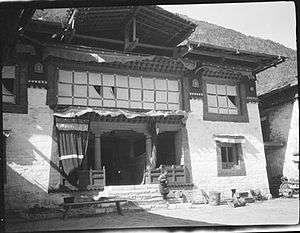Chumbi Valley
Chumbi Valley (Tibetan: ཆུ་འབི, Wylie: chu vbi ; Chinese: 春丕河谷; pinyin: Chūnpī Hégǔ [1]) is a valley in Yadong County, Tibet Autonomous Region, China. The valley is on the south side of the Himalayan drainage divide, near the Chinese border with Sikkim state of India and with Bhutan.[2] The Chumbi Valley is connected to Sikkim to the southwest via the mountain passes of Nathu La and Jelep La.


The valley is at an altitude of 3,000 m (9,800 ft), and being on the south side of the Himalayas, enjoys a wetter and more temperate climate than most of Tibet. The valley supports some vegetation in the form of the Eastern Himalayan broadleaf forests and transitions to the Eastern Himalayan alpine shrub and meadows in the north. The plant Pedicularis chumbica (春丕马先蒿) is named after the valley.
Being on one of the primary routes between India and Tibet, the Chumbi Valley has been at the forefront of several military expeditions. The Delhi Sultanate's attempted invasion of Tibet in 1206 reached the Chumbi Valley. The British military expedition of 1904 occupied the Chumbi Valley for about three years after the hostilities[3][4] to secure Tibetan payment of indemnity. Contemporary documents show that the British continued the occupation of Chumbi Valley until February 8, 1908, after having received payment from China. [5]